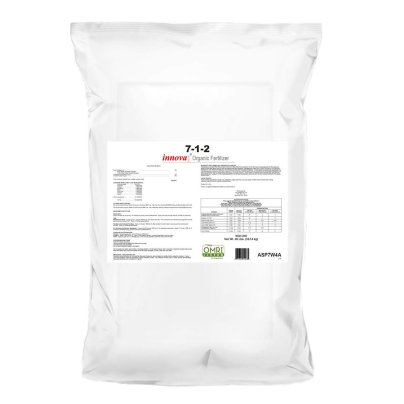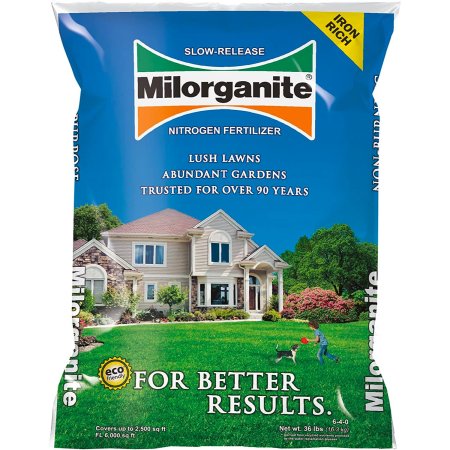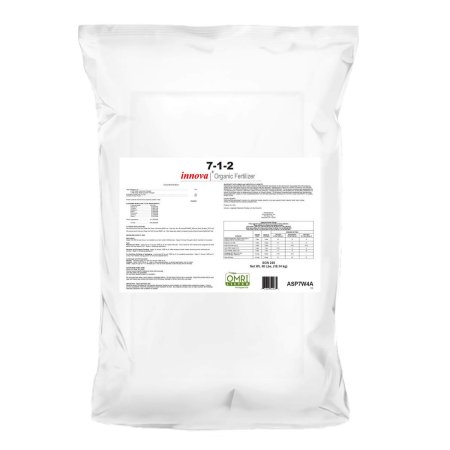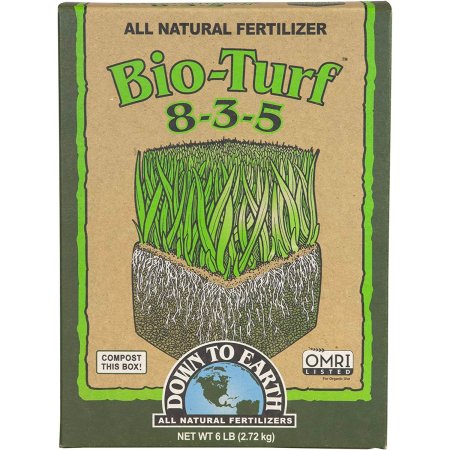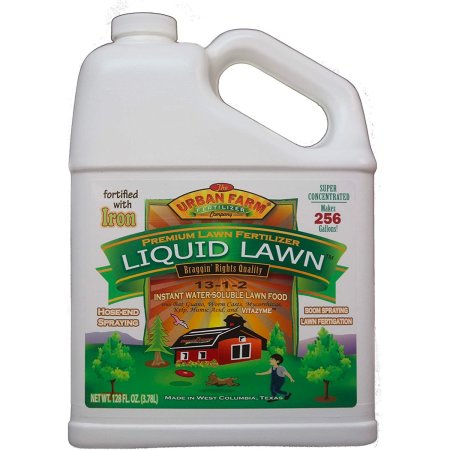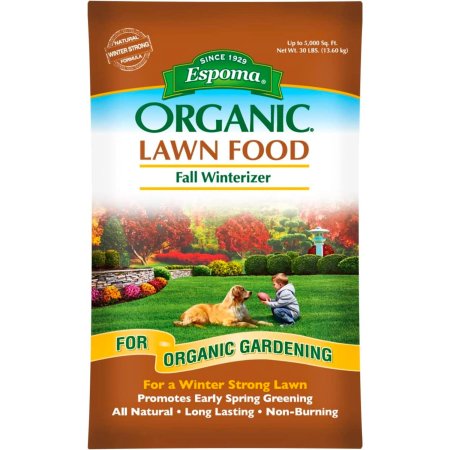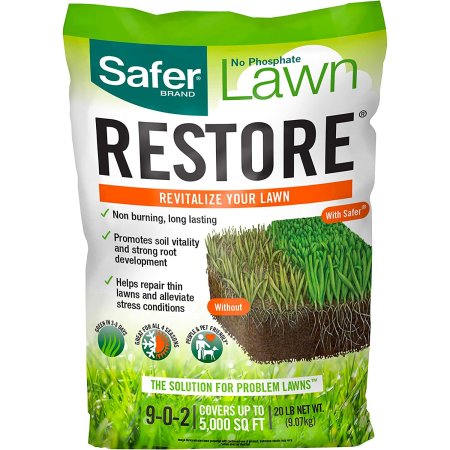
We may earn revenue from the products available on this page and participate in affiliate programs. Learn More ›
A favorite in warm coastal regions due to its ability to tolerate salt, high humidity, and toasty temperatures, St. Augustine grass (Stenotaphrum secundatum) is widely grown in Hawaii, Florida, the Gulf states, and elsewhere in USDA growing zones 8 through 10.
St. Augustine grass thrives in well-drained soil and imparts an appealing blue-green tone to lawns. Although it prefers sunny areas, it tolerates a bit of shade. While this vining-type grass spreads rapidly, it can grow a bit spindly if the soil doesn’t have adequate nutrients, which is the case with a lot of sandy soils in the coastal states. To reach its full, lush potential, St. Augustine grass should be fertilized during the summer growing season.
Our top choice for the best fertilizer for St. Augustine grass is Scotts Natural Lawn Food. Its 29.1-pound package covers 4,000 square feet, and its gentle and effective formula with a 11-2-2 NPK ratio works on freshly seeded or sodded grass.
In addition to our own expertise, we also reached out to Bryan Clayton, CEO of GreenPal, a nationwide lawn care company, who shared some professional tips to help users get the best results. Ahead, learn what to look for when choosing the best fertilizer for St. Augustine grass, and find out why the following lawn fertilizers all fit the bill.
- BEST OVERALL: Scotts Natural Lawn Food
- BEST BANG FOR THE BUCK: Milorganite 6-4-0 Slow-Release Nitrogen Fertilizer
- BEST PLANT-BASED: The Andersons Innova 7-1-2 Organic Lawn Fertilizer
- MOST VERSATILE: Down to Earth Organic Bio-Turf 8-3-5 Fertilizer
- BEST LIQUID: Urban Farm Fertilizer 13-1-2 Liquid Lawn Fertilizer
- BEST FOR FALL: Espoma Fall Winterizer Organic Lawn Food
- ALSO CONSIDER: Safer Brand Lawn Restore Fertilizer

Before You Buy Fertilizer for St. Augustine Grass
Clayton shared some expert tips with us from his experience working with St. Augustine grass down in Florida: “For St. Augustine, I usually recommend something with a higher nitrogen content because it helps keep the grass looking lush and green.” He adds, “If you use the right stuff, you’ll see your lawn become more resistant to drought, disease, and pests over time. It’s like feeding your lawn a balanced diet; it gets stronger and looks better for it.”
Be careful, though, he warns. “Overdo it, and you can burn your lawn, encouraging rapid growth that the roots can’t support, leading to weak grass that’s more prone to problems.” His last piece of advice is to “watch out for fertilizers that are high in phosphorus unless your soil test says you need it, because too much phosphorus can mess with the environment.”
All fertilizers contain a different balance of nutrients, so it’s important to base a fertilizer purchase on the lawn’s soil type. Therefore, the first step in choosing a fertilizer for St. Augustine grass is to do a soil test to determine the pH level and whether it lacks specific nutrients. Most communities have county extension agencies that will test the soil’s nutrient content. Once it has been determined which nutrients, if any, are lacking in the soil, it’ll be easier to select an optimal lawn fertilizer.
As Clayton also mentions, it’s important to note that some parts of the country limit the use of phosphorus in lawn fertilizers because of its potentially negative impact on the environment, so be sure to check local regulations before making a purchase.
Fertilizers for St. Augustine Grass Comparison Chart
| Product | NPK Ratio | Quantity | Coverage |
| Scotts Natural Lawn Food | 11-2-2 | 29.1 pounds | 4,000 square feet |
| Milorganite 6-4-0 Slow-Release Nitrogen Fertilizer | 6-4-0 | 32 pounds | 2,500 square feet |
| The Andersons Innova 7-1-2 Organic Lawn Fertilizer | 7-1-2 | 40 pounds | 11,000 square feet |
| Down to Earth Organic Bio-Turf 8-3-5 Fertilizer | 8-3-5 | 6 pounds | 1,000 square feet |
| Urban Farm Fertilizer 13-1-2 Liquid Lawn Fertilizer | 13-1-2 | 1 gallon (makes 256 gallons) | Up to 80,000 square feet |
| Espoma Fall Winterizer Organic Lawn Food | 8-0-5 | 30 pounds | 5,000 square feet |
| Safer Brand Lawn Restore Fertilizer | 9-0-2 | 20 pounds | 5,000 square feet |
Our Top Picks
St. Augustine grass looks its best when it gets all the nutrients it needs, which is why periodically applying a general lawn fertilizer will help promote dense growth for a lush lawn. Choosing between liquid, granular, and water-soluble fertilizer is mostly a matter of personal preference. All of the following lawn fertilizers are eco-friendly and suitable for boosting nutrients in a St. Augustine lawn to keep it looking lush.
Best Overall
Scotts Natural Lawn Food
Product Specs
- NPK ratio: 11-2-2
- Quantity: 29.1 pounds
- Coverage: 4,000 square feet
What We Like
- Gentle enough to use on freshly seeded or sodded grass
- Provides a balance of phosphorus and potassium along with nitrogen
- Safe to walk on lawn immediately after fertilizer application
What We Don’t Like
- Some users report that their dogs are attracted to the smell of this fertilizer
To boost and deepen the blue-green color that makes St. Augustine grass so recognizable, consider applying Scotts natural lawn food, which features a nitrogen-rich 11-2-2 nitrogen-phosphorus-potassium (NPK) formulation. Scotts’ turf-building formula is composed of all-in-one particles that evenly distribute the nutrients necessary to improve the grass’s health and boost its color.
This granulated fertilizer feeds lawns up to 4,000 square feet and can be applied with either a drop or a broadcast spreader. For best results, follow the application rate on the bag and water the lawn after applying it. Or, save water by applying the product within 48 hours when rain is forecasted. It’s important to note that this fertilizer contains a small amount of phosphorus, the use of which is limited in some regions.
Get the Scotts fertilizer at Amazon or The Home Depot.
Best Bang For The Buck
Milorganite 6-4-0 Slow-Release Nitrogen Fertilizer
Product Specs
- NPK ratio: 6-4-0
- Quantity: 32 pounds
- Coverage: 2,500 square feet
What We Like
- Available at a more affordable price than other organically derived lawn fertilizers
- Designed to promote root growth, add color, and increase lawn density
- Slow-release fertilizer allows users to fertilize their lawns less frequently
What We Don’t Like
- Formula lacks potassium, which some lawns may require
Organically derived lawn fertilizer tends to come at a significantly higher cost than synthetic fertilizer, but Milorganite’s fertilizer derived from biosolids is affordable. It provides a gentle nitrogen boost to add color to St. Augustine grass while increasing the density of the lawn, and it does so without any synthetic ingredients. This product is made from composted manure, and it offers a beneficial 6-4-0 NPK formulation.
Milorganite comes in a 32-pound bag of granules that can be applied with a drop spreader or a broadcast spreader, and a single bag will feed up to 2,500 square feet of lawn.
Get the Milorganite fertilizer at Amazon, The Home Depot, or Walmart.
Best Plant-based
The Andersons Innova 7-1-2 Organic Lawn Fertilizer
Product Specs
- NPK ratio: 7-1-2
- Quantity: 40 pounds
- Coverage: 11,000 square feet
What We Like
- Low quantity of dust granules makes this product easier to apply
- Entirely plant-based and contains no animal parts or byproducts
- Nonburning formula ensures that users can avoid over-application
What We Don’t Like
- Not readily available from all major retailers and may be difficult to find in person
The Innova organic fertilizer from The Andersons features a 7-1-2 NPK ratio and added amino acids in a slow-release formula. It’s made from entirely plant-derived ingredients with no biosolids, manure, composted waste products, or animal parts. It’s designed to have a low quantity of dust granules, which means that users won’t have to worry about breathing in dust while applying the fertilizer.
The 40-pound bag fertilizes up to 11,000 square feet of lawn, and the nonburning formula is perfect for beginners who may tend to inadvertently over apply the product.
Get The Andersons fertilizer at Amazon.
Most Versatile
Down to Earth Organic Bio-Turf 8-3-5 Fertilizer
Product Specs
- NPK ratio: 8-3-5
- Quantity: 6 pounds
- Coverage: 1,000 square feet
What We Like
- Inclusion of potassium protects against drought and temperature changes
- Not only is this product suitable for all grass types, but it can also feed vegetable gardens
- High nitrogen level is designed to promote greener grass
What We Don’t Like
- More expensive than some of the other organic lawn fertilizers available
- Not readily available from many major retailers
With an NPK ratio of 8-3-5, this Down to Earth fertilizer contains a higher ratio of nitrogen to boost lawn growth early in the season. The dose of potassium reduces seasonal stress due to temperature change and drought. The ingredients include hydrolyzed feather meal, blood meal, meat meal, bone meal, and langbeinite. This product is even nutritious enough to feed crops like corn, tomatoes, and leafy greens, making it incredibly versatile.
The 6-pound bag feeds up to 1,000 square feet of lawn, though larger bags are also available. It’s listed by the Organic Materials Review Institute (OMRI) for use in organic gardening.
Get the Down to Earth fertilizer at Amazon.
Best Liquid
Urban Farm Fertilizer 13-1-2 Liquid Lawn Fertilizer
Product Specs
- NPK ratio: 13-1-2
- Quantity: 1 gallon (makes 256 gallons)
- Coverage: Up to 80,000 square feet
What We Like
- Concentrated formula provides up to 80,000 square feet of coverage
- Inclusion of iron promotes the growth of dark green grass
- Combination formula includes animal- and plant-based ingredients for optimal performance
What We Don’t Like
- Must be applied more frequently than slow-release fertilizers at 2 to 3 times per month
This liquid fertilizer from Urban Farm Fertilizer works instantly, providing a high dose of nitrogen as well as smaller quantities of potassium and phosphorus. It also contains an iron supplement for lawns experiencing an iron deficiency. The formula includes both plant-based and animal-based ingredients, with bat guano, sea kelp, worm castings, humic acid, hydroponic-grade minerals, and more.
The ultraconcentrated formula comes in a 1-gallon jug that produces 256 gallons of fertilizer when diluted, allowing it to cover up to 80,000 square feet. However, the major downside to all liquid fertilizers is that they need to be applied more frequently. The manufacturer recommends applying this product every 2 to 3 weeks.
Get the Urban Farm fertilizer at Amazon, Walmart, or The Urban Farm.
Espoma Fall Winterizer Organic Lawn Food
Product Specs
- NPK ratio: 8-0-5
- Quantity: 30 pounds
- Coverage: 5,000 square feet
What We Like
- Specifically formulated for winterizing lawns
- Suitable for all lawn types, including lawns that have recently been seeded or sodded
- Features a nonburning formula, so users needn’t worry about overfertilization
What We Don’t Like
- Since it’s formulated for use in fall, this fertilizer may not be the best year-round option
Those looking to prepare their St. Augustine grass for winter should consider Espoma’s organic fall fertilizer, which provides the nutrients needed during its dormant months. It’s designed to be applied at the end of the summer season, between September and November, depending on the region.
The fertilizer is rich in both nitrogen and potassium, with an NPK ratio of 8-0-5, and the nonburning formula ensures that overfertilization isn’t an issue. It’s suitable for St. Augustine grass and other lawn types as well as lawns that have been recently seeded or sodded. However, the manufacturer recommends applying this product to a dry and recently mowed lawn.
Get the Espoma fertilizer at Amazon or Walmart.
Also Consider
Safer Brand Lawn Restore Fertilizer
Product Specs
- NPK ratio: 9-0-2
- Quantity: 20 pounds
- Coverage: 5,000 square feet
What We Like
- Works quickly, providing results in 3 to 5 days
- Nonburning formula ensures that it’s nearly impossible to overfertilize
- High-nitrogen fertilizer helps to promote robust root systems
What We Don’t Like
- Some users complain that the formula has been changed from a previous version
Another great option for feeding St. Augustine grass is the Safer Brand Lawn Restore fertilizer. It’s designed to treat struggling lawns and helps grass combat stressors like drought and extreme temperature shifts.
It contains natural fertilizer ingredients, including feather meal, soybean meal, blood meal, alfalfa meal, molasses, and sulfate of potash, which combine for an NPK ratio of 9-0-2. This formula’s high dose of nitrogen is designed to strengthen root systems to create a thicker turf. The makeup of the ingredients is designed to increase biological activity in the soil while nourishing the grass. The 20-pound bag feeds 5,000 square feet of lawn.
Get the Safer Brand fertilizer at Amazon or Ace Hardware.
Or, DIY Your Own Fertilizer for St. Augustine Grass
While there are plenty of commercially produced organic lawn fertilizers on the market, it’s also possible to DIY your own homemade fertilizer for St. Augustine grass.
Start by gathering kitchen scraps like fruit peels, vegetable waste, eggshells, and coffee grounds. These items are rich in nutrients such as nitrogen, phosphorus, and potassium, which are vital for St. Augustine grass growth. Create a compost pile or bin in the yard. Layer the collected organic materials with dry leaves, grass clippings, and small branches. Turn the pile regularly to speed up decomposition and ensure an even distribution of nutrients.
Once the compost is ready, fill a large bucket with water and add a few handfuls of compost. Let it steep for 24 to 48 hours, stirring occasionally. This process extracts nutrients from the compost, creating a nutrient-rich liquid known as compost tea. To avoid burning the grass, dilute the compost tea by mixing it with an equal amount of water. Using a watering can or sprayer, evenly distribute the diluted compost tea over the St. Augustine grass.
Jump to Our Top Picks
How We Chose the Best Fertilizers for St. Augustine Grass
When gathering our list of top picks for St. Augustine grass fertilizer, we made sure to include as many types of fertilizer as possible to offer a wide range of options, from granules to liquid sprays.
Our research showed us that different fertilizers require a variety of feeding schedules, from anywhere between every few weeks, to only during the growing months, to all year round. We made sure to include options covering all of these types of fertilizer, so you can opt for the product that best suits your lawn care needs.
That said, we also chose products according to our sustainability guidelines and prioritized environmentally friendly products. That’s why we didn’t include options with synthetic fertilizers, such as Scotts Southern Turf Builder Lawn Food and Pennington 100536576 UltraGreen Lawn Fertilizer, despite their popularity.
What to Consider When Choosing a Fertilizer for St. Augustine Grass
Fertilizing adds essential nutrients to soil that plants need to thrive. By and large, St. Augustine grass will benefit from the same fertilizers used on other grass types.
NPK Ratio
Lawn and turf fertilizers are labeled with the amounts, by weight, of three specific nutrients they contain: Nitrogen (N) brings out the color in the grass and speeds growth, phosphorus (P) encourages bud and seed formation, and potassium (K) encourages healthy plant growth. While all three are required for St. Augustine grass to grow well, the nutrient that soils lack most is nitrogen.
St. Augustine grass usually contains more nitrogen than phosphorus and potassium. A typical turf fertilizer formulation, for example, has an NPK ratio of 15-1-5. When browsing lawn fertilizers, you will notice how many different NPK combinations they offer, but nearly all of them are highest in nitrogen.
Liquid vs. Granular vs. Water-Soluble
Lawn fertilizers are made in three main formulations: liquid, granular, and water-soluble. There’s no “right” option here—the form of fertilizer that’s best is mostly a matter of personal preference.
- Liquid: For a quick boost of growth, many growers and groundskeepers opt to apply liquid lawn fertilizer because it’s quickly absorbed through the blades of grass and immediately goes to work, encouraging new growth. Results can be seen in as little as 3 or 4 days after applying liquid fertilizer to St. Augustine grass. The product can be purchased either full strength or in a liquid concentrate for diluting and applying via a pump-type garden sprayer. The caveat with liquid fertilizers is that they quickly pass through and out of the lawn, so they may need to be applied more frequently than granular types.
- Granular: Resembling tiny grains, granular fertilizers contain many of the same nutrients that liquid fertilizers contain. They differ slightly in that granular fertilizers are often released more slowly, which means the grass’s roots can access the nutrients over an extended period. Granules won’t provide the same rapid greening-up that liquid fertilizers will, but they typically require less frequent application. Granular fertilizers are applied to the lawn using a spreader.
- Water–soluble: Though this fertilizer comes in a granular form, it’s not meant to be applied with a spreader. Instead, water-soluble fertilizers are made to be applied using a hose-end dispenser that connects to a garden hose. The water flows through the dispenser, dissolving and diluting the granules and dispersing the fertilizer via a hand-held sprayer. Like liquid fertilizer, water-soluble fertilizer can green up the lawn fairly quickly.
Organic vs. Synthetic
Most lawn fertilizers contain chemical and synthetic ingredients, but a few are made from totally natural components.
- Organic: Natural organic fertilizers contain the same nutrients as synthetic fertilizers, but they come from natural sources, such as earthworm castings and composted manure. They’re usually more expensive than synthetic formulations because it takes more work to gather the ingredients and process them into fertilizer. The upside is that organic fertilizers are eco-friendly and unlikely to pollute waterways or harm aquatic life.
- Synthetic: Chemicals made in a laboratory to mimic the nutrients found in nature are the main components of synthetic fertilizers. Depending on the product, synthetic fertilizers may also be enriched with essential minerals found in healthy soil, such as calcium, magnesium, or boron. While lawns will react to both types of fertilizers favorably, the high nutrient content in some synthetic fertilizers can harm aquatic life if it runs off in waterways. We have omitted synthetic fertilizers from consideration for this article because of the potentially negative environmental impact.
Application
Knowing when to fertilize is just as important as using the right fertilizer. St. Augustine grass should be fertilized for the first time in spring only after turning a fully green color. Fertilizing it before that time may damage the grass. Apply an all-purpose lawn fertilizer that’s high in nitrogen at the rate recommended on the package. After that, St. Augustine grass should be fertilized every 6 to 8 weeks, depending on the product’s recommendations.
St. Augustine grass doesn’t grow well from seed, so it’s usually propagated through sod or plugs. When starting a new lawn of St. Augustine, apply a lawn-starter fertilizer that offers a balanced ratio of nutrients to the ground beneath the sod. As the roots grow downward, the fertilizer will be absorbed and boost plant health. A high-nitrogen fertilizer can be applied a month later, followed by periodic applications during the growing season. Stop fertilizing in the fall approximately 1 month before outdoor temperatures drop to around 55 degrees Fahrenheit. At this temperature, St. Augustine grass goes dormant and won’t need any fertilizer until spring.
FAQs
The first feeding in the spring should take place a week or two after the grass has entirely greened up. After that, the frequency with which you apply a fertilizer depends on the product’s strength, so follow package directions. In general, every 4 to 6 weeks is usually sufficient.
Applying fertilizer at a rate that exceeds the recommended rate, or applying it more often than is recommended, can result in faster grass blade growth but not necessarily healthier grass. It will, however, result in more frequent mowing.
The most efficient ways to distribute fertilizer is to use a pump-type sprayer to apply liquid fertilizer and a spreader to apply granulated fertilizer. For water-soluble fertilizer, use a hose-end dispenser.
Yes. The caveat here is to wait until after a heavy rain if water is still running off the lawn, which could result in the fertilizer washing away.
When applying a liquid fertilizer—no. Granulated fertilizers may call for watering after application or using the product a day or two before rain is expected.


